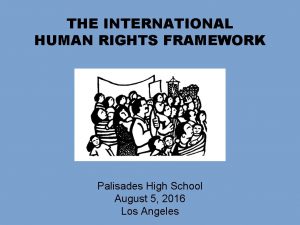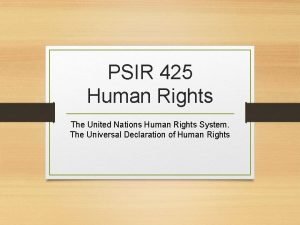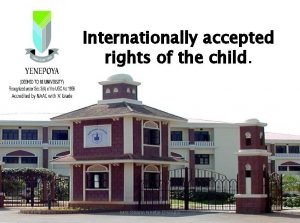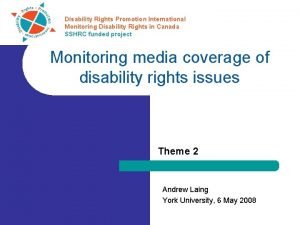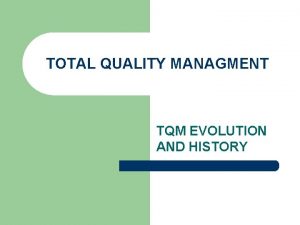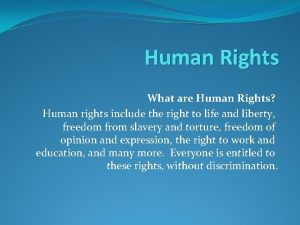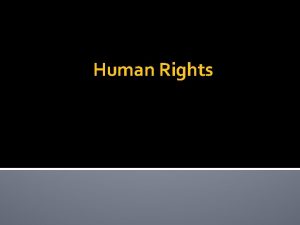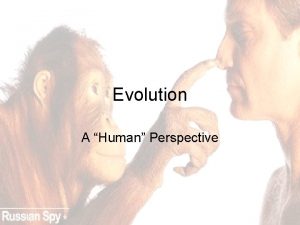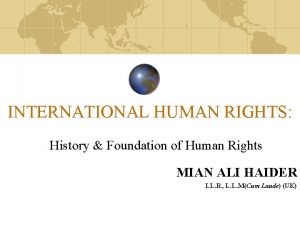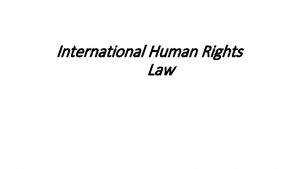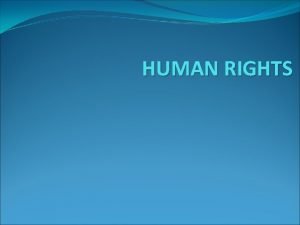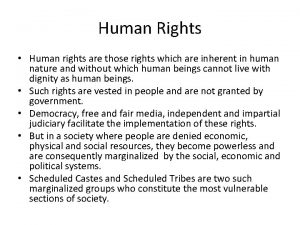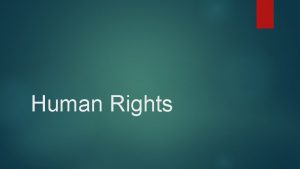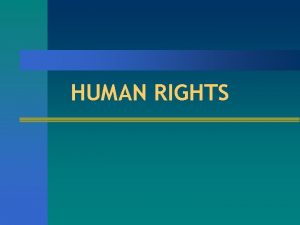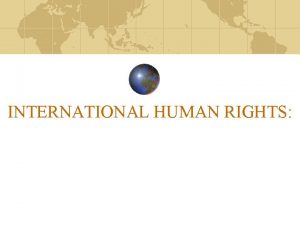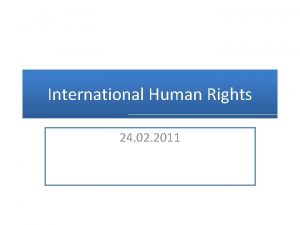EVOLUTION OF HUMAN RIGHTS International History The code

















- Slides: 17

EVOLUTION OF HUMAN RIGHTS

International History � The code of Hammurabi (1750 BC): � � � Hammurabi, the ruler of Babylonia issued a law code to administer his kingdom. There were 282 law codes regarding trade, labour, property, family and slavery. He followed “eye for an eye” punishment. The code was discovered on a stone column in Iran in 1901. The Judeo Christian Traditions (1200 BC – 100 AD): Jesus preached that “rights come with responsibilities” and urged his followers to feed the hungry, clothe naked and forgive their enemies. � He criticized hypocrisy and treated women, poor and foreigners with dignity. � � Confucius (551 -479 BC): � � � Confucius said “Do not do to others what you would not like yourself”. His teachings were stored in Analects, which were spread by his disciples in China. The Magna Carta (1215 AD): � � � English King John I imposed heavy taxes on his ‘people’ to finance wars. Due to his policies a political crisis aroused at that time. Magna Carta (The Great Charter) was issued by the king for the solution of the crisis. It established that everyone, including king, was subject to law. There were 63 clauses in this charter.

History � The Treaty of Westphalia (1648): This treaty ended the 30 years war which started in 1618 in Roman Empire. This treaty became the base of modern concept of national sovereignty by freeing state rulers from the authority of Catholic Church. � Religious tolerance was encouraged and the concept of freedom of worship was built. � � � The English bill of Rights (1689): English Parliament passed a bill in 1689. This bill forbade the Royalty to suspend the laws without Parliament’s consent. � It ordered free elections for members of Parliament and ensured freedom of speech in Parliament. � It also laid certain basic civil rights. � It prohibited cruel and unusual punishments. � � � The US Declaration of Independence (1776): The war of independence in America was carried on by the thirteen American colonies against Great Britain. � This war paved the way for adoption of United States Declaration of Independence and formation of first government of 13 US colonies. � This declaration was largely based on Locke’s and Montesquieu’s ‘Natural Rights’ theories. �

History � Virginia Declaration of Rights (1776): In this fundamental rights and freedoms for people of Virginia were recognized. � This declaration served as the base model for Bills of Rights and French Declaration of Rights of Man and the Citizens. � � The US Constitution (1787) and The Bills of Rights (1791): The US Constitution is the oldest written national constitution in use. It defines principal components of government and their jurisdictions and basic rights of citizens. � First ten amendments to the constitution, known as The Bills of Rights came in 1791. � It protects freedom of speech, religion, assembly, freedom to petition and right to keep and bear arms. � It also prohibits unreasonable search and seizure, cruel and unusual punishments and compelled self incrimination. � � � The French Declaration of Rights of Man and the Citizens (1789): French Declaration was influenced by American Revolution. In France, rights were denied which resulted into a revolution and they adopted French Declaration of the Rights of Man and of the Citizen. � In this declaration legal rights of a citizen were recognized. � It defined natural rights as “liberty, property, security and right to resist � �

History � The Proclamation of Emancipation (1863): � Abraham Lincoln issued this Proclamation during third year of civil war. � It freed the people held as slaves and helped in passing 13 th Amendment which outlawed Slavery nationwide in 1865. � The Geneva Conventions (1864, 1949): � First international treaty which governs the conduct of nations during war time is known as The Geneva Conventions 1864. � It was initiated by The International Red Cross. � It was formed for the help of sick and wounded soldiers. � Mohandas Karamchand Gandhi Philosophy (18691948): � Gandhiji agitated against racism directed at Indians in South Africa. � His philosophy was based on non-violence and respect for life. � He called it Satyagraha, which means force of truth. � He supported various movements in India against caste discrimination, for women rights and for basic education.

History � The United Nations Charter (1945): � After Second World War in 1945, fifty one states signed the UN charter for establishing UNO. � The objective of establishing this organization was to maintain peace, security and cooperation across nations. � The conflicts or problems across nations are solved through this organization. � The Universal Declaration of Human Rights (1948): � UN formed a commission, under the leadership of Eleanor Roosevelt to clarify charter’s references to human rights. � As a result of this, UN General Assembly adopted Universal Declaration of Human Rights (UDHR) in 1948. � This was drafted by representatives of different legal and cultural background from all over the world. � This declaration is about universal goals related to 8 human rights and freedoms. � It sets out, for the first time, fundamental rights to be universally protected.

Human Rights Movement in India

Human Rights in Ancient India � � � Vedic literature states the equality of all human beings and promotes the sense of fraternity amongst them all. It says about equal claims of the human beings on the basic life supporting amenities like food, water, air and shelter. It believes in the ideal of ‘Sarve Bhavantu Sukhinah’. Concept of Dharma (righteousness) denotes all human rights and duties. The Smritis and the Puranas were collections of civil rights and criminal liabilities (Vyavahara Dharma) and also Raja Dharma (Constitutional Law). Kautilya tried to supplement the civil and legal rights of people with the economic rights. Arrival of the Muslim rulers added new elements in the socioeconomic and political life of the country, which impacted the realization of the human rights by the common people adversely. By the time British arrived in India, majority of people were deprived of their human rights.

Human Rights in Pre. Independence Period � � � Raja Rammohan Roy: Worked for the abolition of the cruel and inhuman practices like Sati, child marriage, devadasi system etc. He provided various solutions like widow remarriage, equal rights of women to property and fixation of an appropriate age of marriage for women. William Bentick supported him and helped in abolition of the Sati system by 1823. In 1823, British tried to control the freedom of Press in the country. Rammohan Roy opposed it. Jury Act of 1827 inserted a clause which proposed that ‘Hindu or Muslims are subject to judicial trial by Christians, but Christians are exempted from being tried either by a Hindu or Muslim juror’. Rammohan Roy filed a petition against this which was signed by both Hindus and Muslims. In Maharashtra, Jyotiba Phule in 1873 founded Satyasodhak Samaj to seek the protection of the human rights of the people belonging to the oppressed castes. Justice M. G. Ranade founded the Indian Social Conference in 1887 for the purpose of working towards the realization of a dignified and respectful life for the socially disadvantaged sections of society.

Human Rights in Pre. Independence Period � � Raja Rammohan Roy and Ishwar Chandra Vidyasagar received help from David Hare, Sister Nivedita and Darezio. William Bentick helped in struggle for upliftment of social status, protection of human rights and in empowering them through education. Various socio-religious reform movements contributed towards the growth of human rights movement: � � � � Movement launched by Sri Narayan Guru in South India Arya Samaj founded by Swami Dayanand Saraswati Ramakrishna Mission founded by Swami Vivekanand Aligarh School founded by Syed Ahmad Khan These movements were also launched for protection of rights of various marginalized sections of society and brought social awakening amongst masses. They started demanding their basic liberties from British rulers. In 1895, when Constitution of India Bill was drafted, it called for guarantee of civil and political rights as fundamental rights of people in future constitution for India. This was also known as Home Rule Bill. In Madras Session in 1927, Congress adopted a resolution for inclusion of Declaration of Fundamental Rights in the future constitution of country.

Human Rights in Pre. Independence Period � Motilal Nehru Committee report (1928) enumerated following rights: � � � Personal Liberty and inviolability of dwelling place and property Freedom of conscience and of profession and practice of religion, subject to public order or morality Right to free expression of opinion and to assemble peacefully and without arms, and to form associations and unions, subject to public order or morality Right to free elementary education without distinction of caste or creed in matter of admission in any educational institution maintained or aided by state; Equality of all citizens before law; Right of every citizen to writ of habeas corpus (it directs the prison warden, to produce the prisoner and justify the prisoner’s detention in front of court); Protection in respect of punishment under export laws; Non-discrimination against any person on grounds of religion, caste or creed in matter of public employment, office or power or honour and in the exercise of any trade; Equality of rights to all citizens in the matter of access to, and use of, public roads, public wells and all other places of public resort; Freedom of forming associations for the maintenance and improvement of labour and economic conditions; The right to keep and bear arms in accordance with regulations; and Equality of rights to men and women as citizens.

Human Rights in Pre. Independence Period � � The biggest thrust in this direction came in 1930 s. In Karachi Session of 1931, The Congress Party passed the first resolution demanding civil liberties and equal rights for citizens. In 1934, Indian Civil Liberties Union (ICLU) was formed to ensure legal assistance to freedom fighters. But its functioning remained confined to collection of information about violations of civil liberties. ICLU led to the formation of a number of civil liberty unions like: � � Bombay Civil Liberties Union Madras Civil Liberties Union Punjab Civil Liberties Union. But later on, when Congress led provincial government was formed in 1937, under the provisions of the Government of India Act, 1935, the movement of civil and political rights of the people started being lost. ICLU and other unions came in direct conflict with the Congress party. ICLU could not sustain itself for long. The leaders forgot the promises made for guaranteeing certain basic fundamental rights to the people once they came to power in the country.

Human Rights in Post Independence Period � � After independence, Constituent Assembly was set up to fine-tune the provisions on fundamental rights of the people. The agenda of nation building, national security, unity and integrity was dominating in the minds of the framers of the Constitution. So they could not rise above the routine offerings to the people by way of the fundamental rights. Even the routine fundamental rights were framed with much of ‘restrictions’. When the constitution making process was going on in India, a major international event took place in 1948. United Nations General Assembly adopted the Universal Declaration of Human Rights (UDHR). This gave a new momentum to the human rights movement in the newly independent country. Almost all the countries, found it somewhat compelling to sign the UDHR and also to make changes in their own laws or constitutions to reflect the ethos of the Universal Declaration. So, as a result, the Constitution of India also incorporated a number of valuable provisions. The three main sections containing provisions for rights of the people were: The Preamble The Fundamental Rights (Given in Part III of the constitution) Right to equality Right to freedom Right against exploitation Right to religious freedom Cultural and educational rights Right to constitutional remedies � The Directive Principles of State Policy (Given in Part IV of the constitution) � �

Human Rights in Post Independence Period � � � But soon issues of micro human rights violations came into existence. Cases of the displacement of the people for establishment of heavy industries and big multipurpose projects were ignored in the name of nation building. But the promoters of human rights were not convinced by these reasons. They agitated for the protection of human rights. But government started taking repressive actions against them. Because of such reaction of government, some of the groups started a violent mode of struggle in the form of Naxalite movement. Whereas, some others opted for the democratic and peaceful method to raise the issues of human rights violations. Some of such groups were: Association for the Protection of Democratic Rights (APDR), 1972 � Andhra Pradesh Civil Liberties Committee (APCLC), 1974 �

Human Rights in Post Independence Period � � Most terrifying attack on the human rights came in when National Emergency was imposed in the country by the government of Mrs. Indira Gandhi in June 1975. Democracy and laws were suspended and this resulted into deliberate violations of human rights. This resulted in emergence of more determined associations in various parts of the country to fight on behalf of those whose human rights were violated during the 1975 -77. Some of those associations were: � � � People’s Union for Democratic Rights (PUDR) People’s Union for Civil Liberties (PUCL) Committee for Protection of Democratic Rights (Bombay) Association for Protection of Democratic Rights (Punjab) Banavasi Panchayat (West Bengal) Along with these associations, various non-governmental organizations (NGOs) and individuals struggled and achieved new mile stones in the field of protection and promotion of human rights in country.

Human Rights in Post Independence Period � � � Human rights movement gradually covered other spheres like social and cultural rights, environmental degradation, rights of women and other marginalized sections of society, in addition to civil and political rights of the people. Another such movement was started by Sundarlal Bahuguna, who launched the Chipko Movement in the hills of Garhwal during 1980 s for the protection and promotion of the inherent rights of the natives in the forest resources of the region. Later on similar movements were started by many across the country: � � Medha Patkar began the Narmada Bachao Andolan Aruna Roy started the campaign for ‘Right to Information’ B. D. Sharma fought for the cause of the rights of the tribals of Bastar region. Concept of ‘Public Interest Litigation’ (PIL) added a new dynamism to the movement. Delhi chapter of People’s Union for Democratic Rights filed a petition in Supreme Court on behalf of the unorganized workers hired by the private contractor. They demanded for implementation of the provisions of the Minimum Wages Act. Supreme Court gave a positive response for the efforts of human rights group.

Human Rights in Post Independence Period � It motivated others also. Others who used PIL for protection of human rights were: H. D. Shouri through his NGO ‘Common Cause’ to protect the rights of the consumers � Lawyer M. C. Mehta and the NGO ‘Centre for Science and Environment’ (CSE) to get solutions to the environmental problems of Delhi. � � � Government of India decided to set up the National Human Rights Commission (NHRC) in 1993. Government felt a need for some sort of dedicated national as well as regional bodies that can look into the issues of protection and promotion of human rights of all sections of society with adequate powers and administrative support system. This resulted into establishment of NHRC. Number of other commissions were also established, like: � � � National Commission for Women National Commission for Minorities National Commission for Safai Karamcharis etc.
 International bill of human rights
International bill of human rights International bill of human rights
International bill of human rights Human rights history
Human rights history Code commit code build code deploy
Code commit code build code deploy Negative rights vs positive rights
Negative rights vs positive rights Riparian rights vs littoral rights
Riparian rights vs littoral rights Conclusion of rights
Conclusion of rights Legal rights vs moral rights
Legal rights vs moral rights What is negative right
What is negative right Negative rights vs positive rights
Negative rights vs positive rights Rosalind hursthouse
Rosalind hursthouse Positive rights and negative rights
Positive rights and negative rights Evolution of global marketing
Evolution of global marketing Internationally accepted rights of the child ppt
Internationally accepted rights of the child ppt Disability rights promotion international
Disability rights promotion international International disability rights monitor
International disability rights monitor Clone evolution code
Clone evolution code Tqm history
Tqm history
